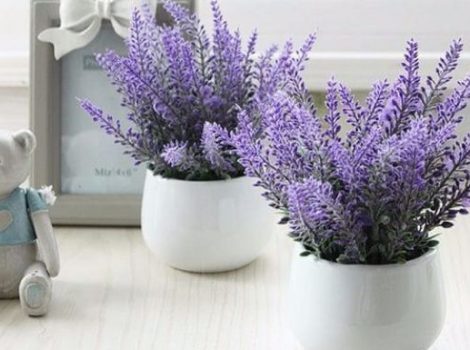Content [show]

When snow is falling outside the window and fluffy snowdrifts lie, it is so nice to see fresh greens on the table! In addition, in winter, natural vitamins are especially needed by our body. And the first helper in the fight against colds or flu is green onions. Phytoncides secreted by onions disinfect the room, destroying bacteria, viruses and fungi.
Smart solutions
Its healing properties help to cope with vitamin deficiency and spring fatigue, increase immunity and improve digestion. Green onion feathers will not only serve as a bright decoration for dishes, but will also have a beneficial effect on the body.
Although green onions can be bought in the supermarket both winter and summer, they are not comparable to those grown on your own windowsill. Firstly, by planting green onions at home, you can pick the required number of feathers for cooking at any time, and secondly, you will be sure that the greens were grown without the use of any harmful substances and chemicals.
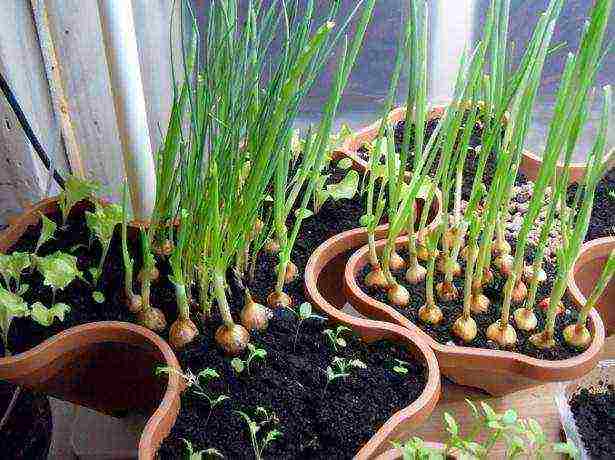
By planting green onions at home, you can pluck the required number of feathers at any time for cooking.
Growing onions at home may seem affordable to any child - stuck a bulb in the ground in a flower pot and watch how green feathers appear. However, if you decide to get serious about the matter and eventually collect a rich harvest of not only greens, but also the bulbs themselves, you will need to take into account a number of basic rules and nuances.
Video about growing green onions at home
Instructions on how to grow green onions at home
In winter, you can get greenery from the bulbs by forcing them onto a feather, that is, by germinating the root crops themselves. For this, onions are usually used, which you grew in your garden or bought in the store. Multi-primordial varieties are optimal (Timiryazevsky, Spassky, Strigunovsky, Arzamassky, Pograsky, Soyuz). The bulbs should be approximately the same diameter - about 2 cm, not damaged or diseased.
Place the calibrated bulbs in a container with hot water (+40 degrees) and put them on the central heating battery for a day. After soaking, a layer of brown husk can be removed to ensure the quality of the selected root crops and to remove the damaged layer, if any. Before planting, the top of the bulbs is cut off by one and a half centimeters.
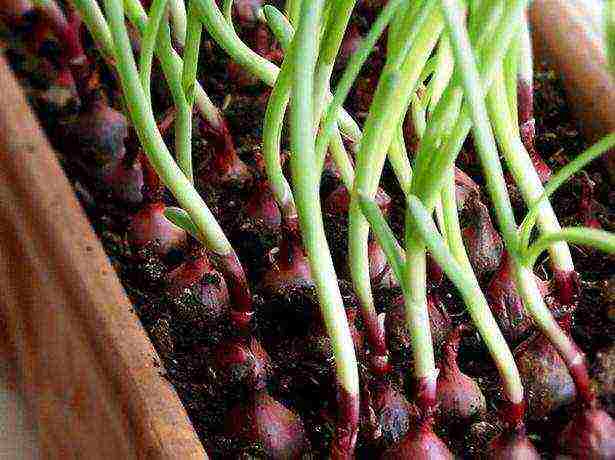
In winter, you can get greenery from the bulbs by forcing on a feather.
Prepare the soil in the container
To sprout onions at home, you can use any boxes, bowls, containers or pallets with a depth of 7 cm or more.It is best to prepare two containers so that you can grow green onions in a conveyor way - then you do not have to wait for the next portion of onion feathers to sprout.
As a soil, you can use land or substrate: fine expanded clay, fine gravel, sand. The substrate should be pre-washed with a hot concentrated solution of potassium permanganate and running water. Fill the boxes with soil 3-4 cm, if you chose a substrate, fill it with water so that it covers the surface by 1 cm. Dip the prepared bulbs into the ground every two centimeters, keeping them upright. It is not necessary to deepen the onion too much, only the roots should be in the water, otherwise the bulbs will rot.
Further care of greens 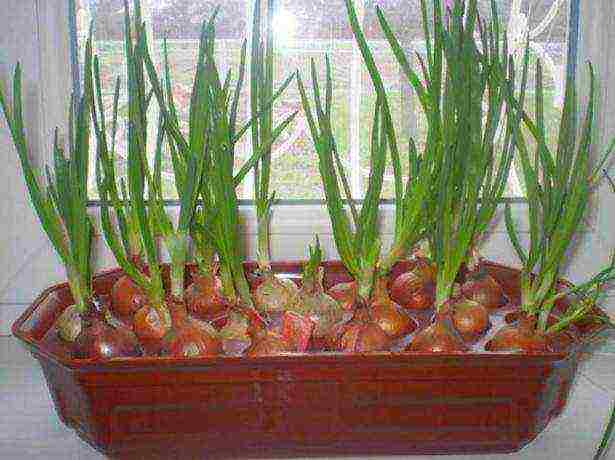
Water the planted bulbs every other day with warm water
The container is placed in a warm place for a week, where the temperature does not drop below +25 degrees. When feathers 1-2 cm high appear on the bulbs, you should transfer the box to the windowsill. Windows that face southwest, south and southeast are ideal. If there is not enough sunlight, you can additionally illuminate the containers with fluorescent lamps. Only in the presence of sufficient light will green onion feathers accumulate useful substances and acquire a rich taste.
Water the planted bulbs every other day with warm water. Make sure that the water is constantly at a level just below the surface of the substrate, and the soil does not dry out.
The first green feathers should not be cut, otherwise further growth of greenery will stop. Cutting is done three weeks after planting the onion, and it is better to cut off the outermost feathers first, since the feather grows back from the middle. In order for the greens to grow continuously, the interval between plantings in different boxes should be 10-12 days.
Video about growing green onions
Growing green onions in water
There is another popular way to grow onions at home without using potting soil. The bulbs are processed as described above and stacked tightly in an upright position on a shallow tray. Water is poured into the pan so that it covers the bulbs by a quarter. As the water level decreases, you will need to refill it. In about two weeks you will have fresh green feathers ready to eat.
The greens do not need additional feeding, since it takes all the nutrients during growth from the bulbs. But to accelerate the regrowth of feathers, you can add water with wood ash dissolved in it (10 liters 50 g).
In winter and autumn, our menu often lacks fresh herbs. During cold weather, green onions will help to enrich the diet with vitamins. It has a number of useful properties, protects against colds, and destroys viruses. You don't have to buy them in stores to decorate dishes with green onion feathers; green onions are easily grown at home. There are several ways to grow onions, the simplest and most common is forcing on a feather in water.
First, prepare the bulbs for germination. Select a few, about 3 to 4 cm in diameter. Select only whole, undamaged bulbs that are strong and firm. Before placing them in a container of water, dip them in a solution of ash or potassium permanganate, rinse in cold water and peel off the top leaves of the husk. To sprout onions, you will need a container, use glass small jars, glasses, mugs, suitable in diameter. To prevent the onion from rotting, pour a small amount of water, covering only the base of the onion. Also, a way to prevent decay is using a sock. Slip one end of the sock over the onion, and lower the other into the water, rising upward, the moisture will reach the onion and promote germination.
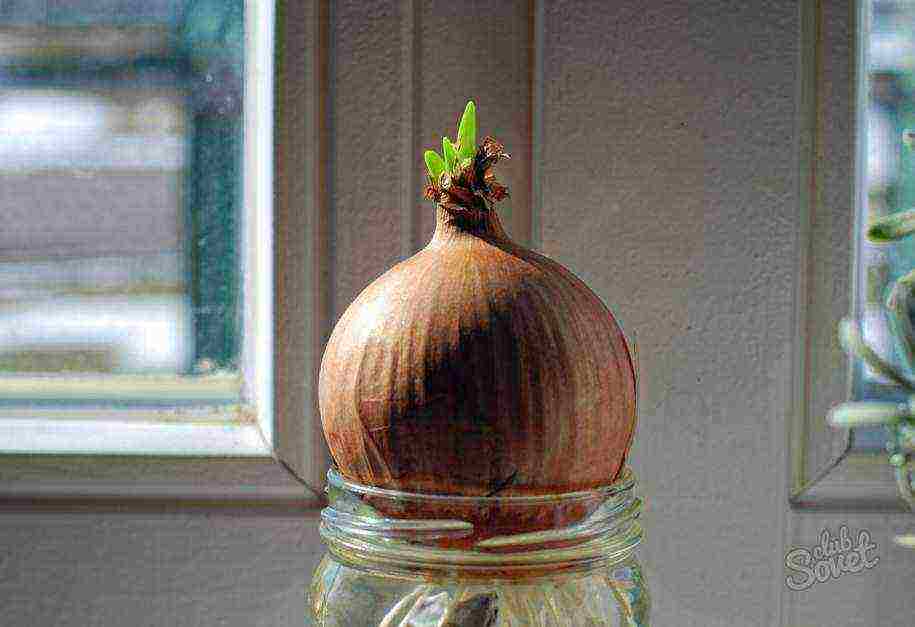
If you want to grow a lot of onions, choose larger containers or plastic salad boxes. You will need thick cardboard in which you can cut holes for the bulbs of the desired diameter. Cover the container with clean water with cardboard and "seat" the onions in the holes, make sure that they only lightly touch the water. An ordinary deep bowl of water is also suitable for sprouting onions. Place the bulbs vertically in it, tightly against each other, and wait for germination. Special "sprouters" working on the principle of hydroponics will help to quickly drive the onions onto the feathers: the device has holes for the bulbs, which do not directly contact with water, but are blown by the water suspension created by the compressor. This method allows you to quickly and efficiently germinate a feather. 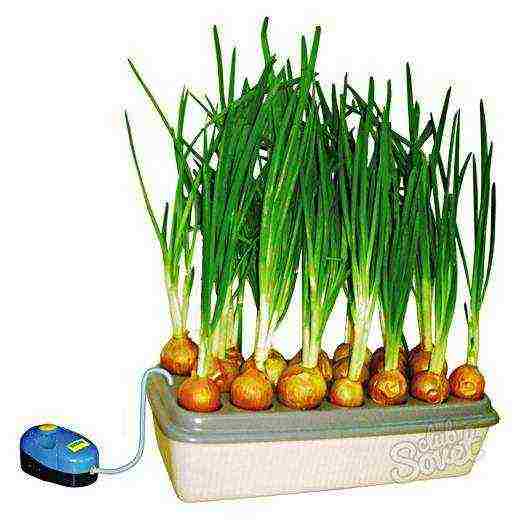 All of these methods will produce the first onion feathers in about two weeks. You can achieve a faster harvest by feeding.Use ordinary mineral fertilizers for plants - 2 tsp. per liter of water or wood ash - 5 g per liter of water. Top dressing should be applied when the growth of greens has already begun, and the onion has taken root.
All of these methods will produce the first onion feathers in about two weeks. You can achieve a faster harvest by feeding.Use ordinary mineral fertilizers for plants - 2 tsp. per liter of water or wood ash - 5 g per liter of water. Top dressing should be applied when the growth of greens has already begun, and the onion has taken root.
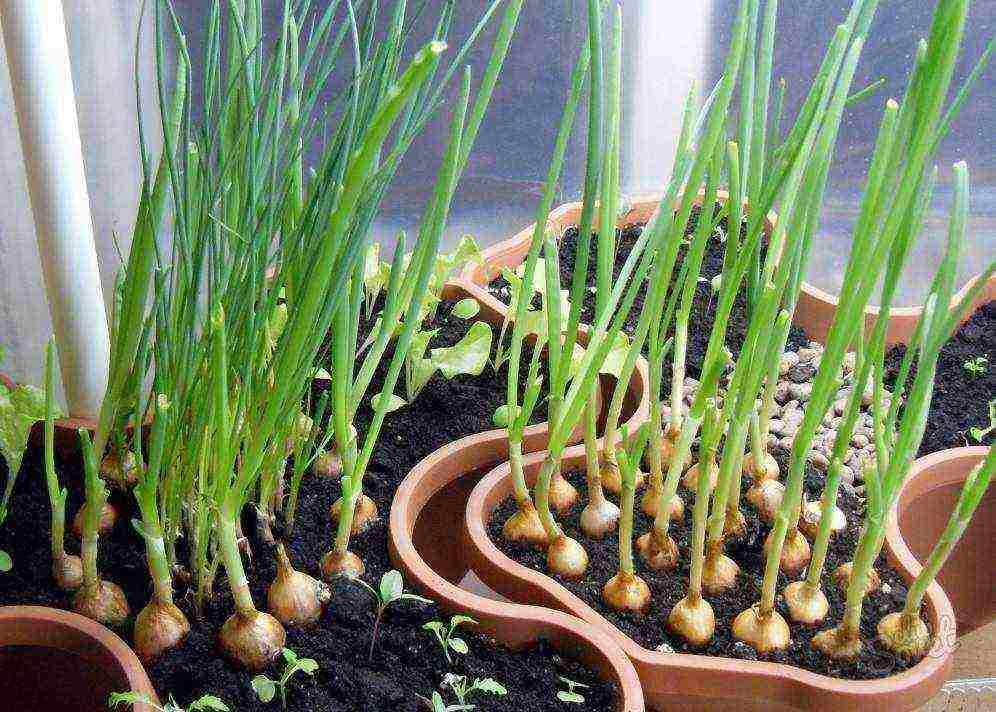
Several rules will help to grow abundant onion greens. Before use, disinfect onion containers with a weak solution of potassium permanganate, this will get rid of putrefactive bacteria. You cannot completely immerse the onion in water, it will rot and deteriorate. Until the roots have grown, it is advisable to keep the onion in a cool place and change the water 2 times a day. After the roots appear, the water should be changed once a day. Remove the onion from the water daily and let it air for 3-4 hours. Rinse the roots occasionally under the tap.
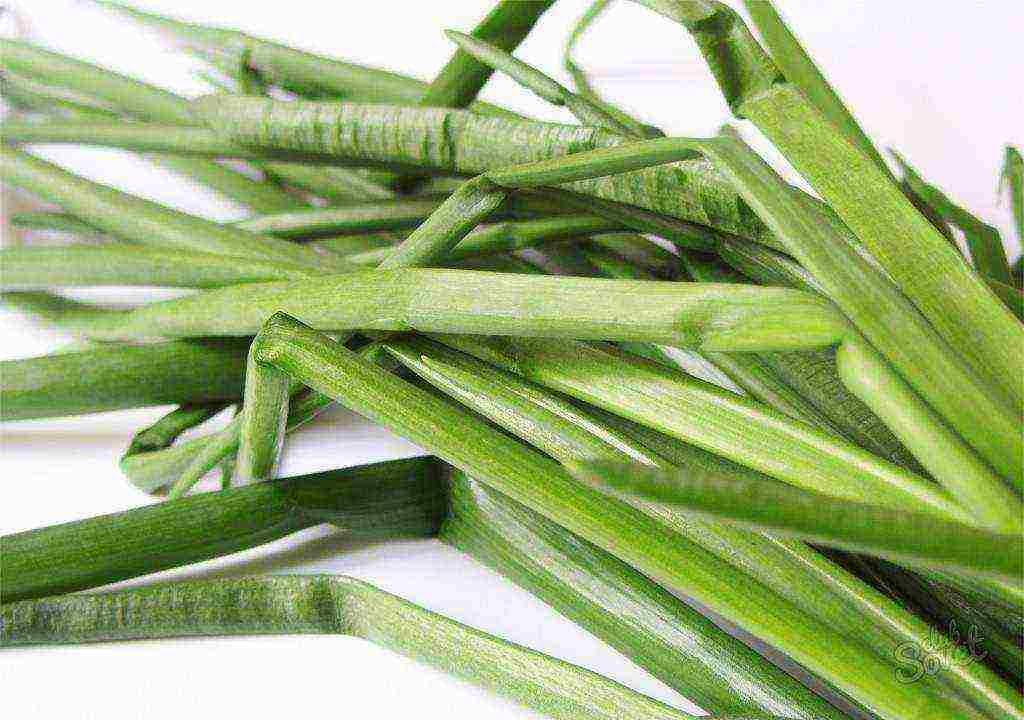
To always have onions on your table, put a new batch for germination every 2 weeks. Growing onions at home is a fun activity that will provide you with fresh herbs even in winter.
How great it is in summer and winter to always have fresh herbs on hand, for example, onion feathers. After all, it is so often needed for salads and pies, and it is very easy to grow it right on the windowsill. In this resource, you will find 2 step-by-step instructions on how to grow green onions at home on water or in soil.
Method 1. How to grow onions for herbs in water
It would seem that this method of growing onions at home is so simple and known to everyone that it does not even require instructions. After all, you just need to put the head in water and wait for the harvest. However, this method has two problems - the rapid decay of the vegetable and the appearance of an unpleasant odor. To minimize these costs and speed up the growth process, we suggest growing onions using the following improved instructions.
What you need:
- Common onion from the store. Ideally, it is best to pick up an already sprouted bow with small arrows. Any medium-sized bow will do, however, as long as the head is firm and healthy.
- A glass or jar with a small neck.
- Standing water.
- Activated carbon 1-2 tablets.
Instructions:
Step 1. First of all, you need to prepare the onion for distillation. To do this, pre-peel the onion from the top layer of the husk, pierce its root cup with a skewer and cut off the top of the head by 1-1.5 cm as shown in the photo (if the onion is already sprouted, then the top does not need to be cut off).
Preparing onions for forcing on water
Step 2. Next, we need to lower the onion into a container of water just enough so that the water covers only its root cup. This is necessary in order for the onion to take root, and it will take root in a day.
Step 3. After one day, when the roots grow on the onion, you can drain a little water from the glass so that the water only covers them and does not touch the cup. This simple trick will keep the onions from rotting and smelling longer.
Step 4. It remains only to wait 2 weeks and during this time periodically change the water. Once the feathers have sprout up to about 15cm, it's time to harvest.
Sprouted onion
Tips & Tricks:
- To prevent the onion from rotting even longer, add 1-2 tablets of activated carbon to the water.
- If you want to sprout a lot of onions at home, while spending a minimum of effort, purchase the Onion Happiness hydroponic plant in the store. It works as follows: 20 heads are inserted into the wells, the container is filled with water, then the compressor creates an air-water environment. Due to the fact that the root cups almost do not come into contact with water, the bulbs do not rot, and due to the saturation of the roots with oxygen, they give 2 crops per month with a length of 30-40 cm.
Also see our other materials:
- It is very convenient to germinate a dozen bulbs in an egg carton on the windowsill at once. To build such a "hydroponic installation" with your own hands, you just need to divide the container into two halves, cut holes in the cells of the upper "tier", and fill the lower "pan" with water and cut off the extra bumps from it.Then fold the two pieces on top of each other and place wooden skewers between them, as shown in the photo below.
- By the same principle, you can also grow leeks bought in a store on the windowsill with your own hands. To do this, cut off the white roots from the feathers (in the photo below), and then place them in a container of water, only 1 cm deep. Leave the roots in water for 2 weeks, changing it periodically (preferably every day). However, a week after forcing, when young shoots appear, the leek can be transplanted into the ground.
Method 2. How to grow onions for herbs in the ground
It is best to grow onions on a feather at home in the ground, and not in water. It is almost as simple, but the bulb will be able to produce at least 2 crops, stand for 1-2 months, and at the same time emit practically no smell. In addition, if you plant turnips in a pretty pot, then your mini-garden will also decorate your windowsill.
What you need:
- Priming. In winter, you can buy a suitable soil in the store (for example, it can be a mixture for cacti with a high content of sand or just a universal soil), and in summer you can take soil from the nearest land plot.
- Several small healthy bulbs, preferably not fresh, but lying down for a couple of months and sprouted. If you wish, you can grow sets on a feather, but then the feathers will have to wait longer, and you will not be able to use the sprouted set a second time. Another alternative to onions is leeks. It must first be germinated in water for 7 days (as described in the first instruction) and only then transplanted into the ground.
- Container, pot, or any other container of a suitable size.
- Standing water for irrigation.
Instructions:
Step 1. From the selected turnips, remove one layer of the upper husk, cut off 1-1.5 cm of the tops (if the bulbs are without sprouts), and then soak their root cups for a couple of hours or more in warm water so that they germinate a little. All of these techniques will speed up feather growth.
Step 2. While the bulbs are soaking, fill the soil with a depth of 4-7 cm into the container.
Step 3. Now we plant the bulbs or sets every 2 cm, but without deepening. That is, so that only the root cups of the heads come into contact with the soil. Remember that the less the bulb is in contact with the soil, the less likely it is to rot. When you have planted all the onions, pour a little warm water over the soil to keep the soil slightly moist without the onions getting wet.
- To plant a set on a feather, you need to use loose soil and plant the onions 1-2 cm deep, tightly to each other.
- To plant leeks, it must also be dug into loose soil to a depth of 2 cm.However, it will take longer to wait for the harvest - about three weeks.
Step 4. You should not immediately place the onion bed on the windowsill: it is better to put it in a dark, cool place for germination for literally a few days. If you have planted an onion that has already lain and sprouted, then this stage can be dispensed with.
Step 5. Well, that's all. Now it remains only to wait a couple of weeks, when the greens grow to 15 cm, and at this time, lightly water the garden once every 3-4 days. You need to cut off mature feathers in the middle of the bunch and not too close to the bulb, then it will have sprouts that will soon give the next harvest.
Tips & Tricks:
- To save space on the windowsill, you can create a vertical bed with your own hands. To do this, take a 5-liter plastic bottle with a stable bottom, cut off its neck, make several holes at the bottom and cut holes on the walls in a checkerboard pattern at intervals of 3-4 cm (you will get about 4 tiers). Then gradually start filling the bottle with soil.
Planting bulbs in a vertical bed from a bottle
- Once the soil reaches the first tier, place the bulbs in the holes as shown in the photo above, water the soil and repeat the above steps to fill the bottle to the very top. Place the bottle on a plate and water the soil every 4 days for 2 weeks.
- Leeks and onions can be grown in the same garden.
- Another secret: to always have fresh herbs in the house, grow onions in 2-3 containers, planting them every 10 days. Then you will have a "vitamin conveyor".
- To speed up the growth process and improve the taste of greens, in the evening and at night, the garden bed on the windowsill can be illuminated with a fluorescent lamp. This advice is especially relevant in winter.
- Also, for greater juiciness, you can periodically spray the feathers, but so that moisture does not get on the turnips themselves.
- In summer, make sure that the temperature in the area of the windowsill where the onion grows does not rise above 30 °. Otherwise, the feather will stop growing. To protect the crop from overheating, you can wrap the tray with foil.
(Rate the material! Already voted: Average rating: out of 5)
Read also:
- How to grow dill and parsley on a windowsill
- How to grow basil on a windowsill
- Indoor flowers and plants for the kitchen - choose unpretentious, useful and beautiful
- How to get rid of midges in flowers
- 8 questions and answers about honey storage
Fresh herbs are rich in vitamins. In order not to know the lack of it in winter, you can grow green onions at home. It contains a large amount of healthy substances - iron, vitamins B and C, iodine. Its essential oils are natural phytoncides that protect against bacteria and viruses. Green onions are used as a spice - they are a natural flavor enhancer.
You can buy this vegetable in the store, or you can grow it yourself on the windowsill. For this, no effort is needed, it does not require special care and constant attention, and the result will exceed expectations.
Growing in the ground
How to grow green onions and get high yields? To maximize the yield, carefully select the planting material and prepare the site for planting. Windows facing south and southeast are suitable for growing, and it is better to drive out greens from rhizomes and root crops in wooden containers or boxes.
Planting material
For planting and subsequent distillation, large seeding, samples, seeds and seedlings are used. The larger the planting material, the higher the yield. Local varieties are chosen for forcing at home. Most often, ordinary medium-sized onions (more than 6-7 cm in diameter) are used as planting material. The bulbs should be chosen healthy, with a bottom without damage and a thin neck. Try to use onion heads grown on your site, and when choosing in a store, choose medium-sized ones that have already begun to sprout. For 1 sq.m. land area needs about 10-11 kg.
If the bulbs have not yet sprouted, their necks must be cut off and soaked in water just above room temperature for a day. This speeds up germination. After a day, we plant them in wooden boxes with prepared soil, the distance between the planted plants should be 1.5-2 cm so that they do not interfere with each other during growth, and the planting depth should be such that half of the bulb is above the soil surface.
Forcing green onions is also possible from seeds. How to grow green onions from them? Before planting, the seeds must be soaked for 10 hours in warm water or a weak solution of potassium permanganate. Then plant it in a container to a depth of 3 cm. You need to sow sparsely so that you do not have to thin out later. Then pour, cover with foil or glass and put in a bright place. Remove the cover only when green onion shoots appear. With proper sowing, it takes up to 10 days before the first shoots emerge from the ground.
When using small bulbs as planting material, be sure to add top dressing to the soil for better germination.
Preparing the landing site
Any container is suitable for forcing green onions at home: from plastic cups and plates to wooden boxes. It all depends on the amount of onions that you decide to grow.
Selected containers must be filled with potting soil. You can buy such a soil at any flower shop or prepare it yourself in the fall. When buying in the store, give preference to the soil mixture for cacti - it contains the largest amount of sand. If you decide to prepare it yourself, take the soil from the garden with humus and mix in equal parts with ordinary sand. When growing green onions from seeds, sow them in well-moisturized soil. Place boxes and containers with planted bulbs in sunny, but not hot places.
Care
Forcing green onions does not require special care. It is worth adhering to only a few rules:
- water for irrigation should be warm (about 35-40 degrees);
- the temperature in the room should be in the range of 18-220C, with a significant increase, onion feathers become sluggish, lowering the temperature to 120C is well tolerated;
- if forcing green onions takes place in a poorly lit room, additional light sources are needed;
- green onions from seeds immediately after germination require mineral feeding.
Many people wonder how to grow green onions without feeding? The answer is simple - high-quality soil and proper watering make it possible to completely abandon additional feeding and get a completely natural crop.
Growing method on water
Forcing green onions does not need to be done in boxes or containers with soil. There is a cleaner and equally effective way to grow green onions at home. For those who do not want to bother with soil, there is a method of germination in water. You can't grow green onions from seeds like that, but this option is suitable for ordinary bulbs. In winter, this approach is very relevant.
Selected bulbs are cut in half without damage and dipped in ash, manganese solution or hot, but not boiling, water for 20-30 minutes. After they are placed in cold water, the husks are completely removed and planted in any container with water: jars, glasses, special containers for germination.
There are several guidelines for getting the best results with this growing method:
- until the roots have grown, keep the dishes in a cool place;
- the water in the container needs to be changed 2 times a day until the roots grow, after that 1 time a day;
- if you add mineral fertilizers, changing the water is permissible once a week;
- to avoid decay of the bulbs, leave them without water for 3-4 hours or dry them with a towel;
- periodically, the roots need rinsing with running water.
The main problem when forcing onions in water is rotting of the bottom. To avoid this, take an old, clean sock or cloth bag and place the onion in it. Water, soaking the fabric, will rise to the roots as needed, this will help to avoid excess moisture.
Video "Home hydroponic plant for growing green onions"
In this video, an overview of a home container for growing onions in hydroponics.
It is best to grow in special germination containers. They are sold in any gardening store. How to grow green onions in such containers is not a great science: the bulbs are placed in the holes intended for them, water is poured into a closed tray and, with the help of a compressor, it is sprayed all the time. The roots practically do not come into contact with water, but they grow quickly and give a good harvest.
Harvesting
In boxes with soil, onions begin to sprout in 2-3 days, and after about 16-18 days, depending on the variety, their feathers can reach 30 cm. Bulbs grown in water give a harvest for 15-17 days. In winter, these periods may increase slightly due to the short daylight hours.
Carefully cut the stems with sharp scissors, do not break off. If the bulb is rotten or shriveled, the root crop should be removed and replaced with another. This will allow you to have fresh greens to the table continuously - in autumn, winter and spring.
Video "Growing green onions at home"
In this video, tips for growing greenery at home. Growing in water (hydroponics) and sawdust.

